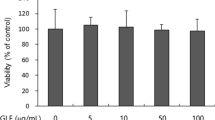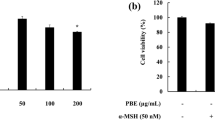Abstract
Agents to control melanogenesis are in demand for the development of cosmetics to improve pigmentation disorders of skin and hair. In this study, we examined and evaluated the effects of flavonoids on melanogenesis in the melanogenic cells model, murine B16F10 melanoma cells. In the course of this study, we found that incubation of the cells in a medium containing 10 μM of the 4′-O-methylated flavonoids, diosmetin (4′-O-methylluteolin), acacetin (4′-O-methylapigenin) or kaempferide (4′-O-methylkaempferol), increased the melanin contents of the cells 3- to 7-fold higher than the control cells. The concentration-dependence test revealed that 20 μM acacetin showed the highest effect, up to 33-fold higher than the vehicle. On the other hand, the corresponding 4′-OH-type flavonoids, luteolin, apigenin and kaempferol, had a significantly smaller effect. Furthermore, by evaluating the melanogenic proteins, we found that the cells treated with 4′-O-methylated flavonoids showed higher tyrosinase activity, as well as upregulation of tyrosinase expression, preceded by activation of cAMP response element binding protein (CREB) and extracellular signal-regulated kinases types 1 and 2 (ERK1/2). These results indicate that the 4′-O-methyl group of flavonoids plays an important role in the induction of melanogenesis by activating its major signal transduction pathway through the upregulation of phospho-CREB in murine B16F10 melanoma cells.





Similar content being viewed by others
References
Rózanowska M, Sarna T, Land EJ, Truscott TG (1999) Free radical scavenging properties of melanin interaction of eu- and pheo-melanin models with reducing and oxidising radicals. Free Radic Biol Med 26:518–525
Horike N, Takemori H, Katoh Y, Doi J, Min L, Asano T, Sun XJ, Yamamoto H, Kasayama S, Muraoka M, Nonaka Y, Okamoto M (2003) Adipose-specific expression, phosphorylation of Ser794 in insulin receptor substrate-1, and activation in diabetic animals of salt-inducible kinase-2. J Biol Chem 278:18440–18447
Katoh Y, Takemori H, Min L, Muraoka M, Doi J, Horike N, Okamoto M (2004) Salt-inducible kinase-1 represses cAMP response element-binding protein activity both in the nucleus and in the cytoplasm. Eur J Biochem 271:4307–4319
Screaton RA, Conkright MD, Katoh Y, Best JL, Canettieri G, Jeffries S, Guzman E, Niessen S, Yates JR 3rd, Takemori H, Okamoto M, Montminy M (2004) The CREB coactivator TORC2 functions as a calcium- and cAMP-sensitive coincidence detector. Cell 119:61–74
Kumagai A, Horike N, Satoh Y, Uebi T, Sasaki T, Itoh Y, Hirata Y, Uchio-Yamada K, Kitagawa K, Uesato S, Kawahara H, Takemori H, Nagaoka Y (2011) A potent inhibitor of SIK2, 3,3′,7-trihydroxy-4′-methoxyflavon (4′-O-methylfisetin), promotes melanogenesis in B16F10 melanoma cells. PLoS One 6:e26148
Shoji T, Masumoto S, Moriichi N, Kobori M, Kanda T, Shinmoto H, Tsushida T (2005) Procyanidin trimers to pentamers fractionated from apple inhibit melanogenesis in B16 mouse melanoma cells. J Agric Food Chem 53:6105–6111
Yokota T, Nishio H, Kubota Y, Mizoguchi M (1998) The inhibitory effect of glabridin from licorice extracts on melanogenesis and inflammation. Pigment Cell Res 11:355–361
Lin VC, Ding HY, Tsai PC, Wu JY, Lu YH, Chang TS (2011) In vitro and in vivo melanogenesis inhibition by biochanin A from Trifolium pratense. Biosci Biotechnol Biochem 75:914–918
Yoon HS, Lee SR, Ko HC, Choi SY, Park JG, Kim JK, Kim SJ (2007) Involvement of extracellular signal-regulated kinase in nobiletin-induced melanogenesis in murine B16/F10 melanoma cells. Biosci Biotechnol Biochem 71:1781–1784
Ohguchi K, Akao Y, Nozawa Y (2006) Stimulation of melanogenesis by the citrus flavonoid naringenin in mouse B16 melanoma cells. Biosci Biotechnol Biochem 70:1499–1501
Fujii T, Saito M (2009) Inhibitory effect of quercetin isolated from rose hip (Rosa canina L.) against melanogenesis by mouse melanoma cells. Biosci Biotechnol Biochem 73:1989–1993
Nagata H, Takekoshi S, Takeyama R, Homma T, Osamura YR (2004) Quercetin enhances melanogenesis by increasing the activity and synthesis of tyrosinase in human melanoma cells and in normal human melanocytes. Pigment Cell Res 17:66–73
Takeyama R, Takekoshi S, Nagata H, Osamura YR, Kawana S (2004) Quercetin-induced melanogenesis in a reconstituted three-dimensional human epidermal model. J Mol Histol 35:157–165
Cos P, Ying L, Calomme M, Hu JP, Cimanga K, Van Poel B, Pieters L, Vlietinck AJ, Vanden Berghe D (1998) Structure–activity relationship and classification of flavonoids as inhibitors of xanthine oxidase and superoxide scavengers. J Nat Prod 61:71–76
Lu J, Papp LV, Fang J, Rodriguez-Nieto S, Zhivotovsky B, Holmgren A (2006) Inhibition of mammalian thioredoxin reductase by some flavonoids: implications for myricetin and quercetin anticancer activity. Cancer Res 66:4410–4418
Li X, Guo L, Sun Y, Zhou J, Gu Y, Li Y (2010) Baicalein inhibits melanogenesis through activation of the ERK signaling pathway. Int J Mol Med 25:923–927
Rauth S, Kichina J, Green A (1997) Inhibition of growth and induction of differentiation of metastatic melanoma cells in vitro by genistein: chemosensitivity is regulated by cellular p53. Br J Cancer 75:1559–1566
del Marmol V, Beermann F (1996) Tyrosinase and related proteins in mammalian pigmentation. FEBS Lett 381:165–168
Bentley NJ, Eisen T, Goding CR (1994) Melanocyte-specific expression of the human tyrosinase promoter: activation by the microphthalmia gene product and role of the initiator. Mol Cell Biol 14:7996–8006
Bertolotto C, Buscà R, Abbe P, Bille K, Aberdam E, Ortonne JP, Ballotti R (1998) Different cis-acting elements are involved in the regulation of TRP1 and TRP2 promoter activities by cyclic AMP: pivotal role of M boxes (GTCATGTGCT) and of microphthalmia. Mol Cell Biol 18:694–702
Hodgkinson CA, Moore KJ, Nakayama A, Steingrímsson E, Copeland NG, Jenkins NA, Arnheiter H (1993) Mutations at the mouse microphthalmia locus are associated with defects in a gene encoding a novel basic-helix-loop-helix-zipper protein. Cell 74:395–404
Gonzalez GA, Montminy MR (1989) Cyclic AMP stimulates somatostatin gene transcription by phosphorylation of CREB at serine 133. Cell 59:675–680
Xing J, Ginty DD, Greenberg ME (1996) Coupling of the RAS–MAPK pathway to gene activation by RSK2, a growth factor-regulated CREB kinase. Science 273:959–963
Du K, Montminy M (1998) CREB is a regulatory target for the protein kinase Akt/PKB. J Biol Chem 273:32377–32379
Yanase H, Ando H, Horikawa M, Watanabe M, Mori T, Matsuda N (2001) Possible involvement of ERK 1/2 in UVA-induced melanogenesis in cultured normal human epidermal melanocytes. Pigment Cell Res 14:103–109
Englaro W, Rezzonico R, Durand-Clément M, Lallemand D, Ortonne JP, Ballotti R (1995) Mitogen-activated protein kinase pathway and AP-1 are activated during cAMP-induced melanogenesis in B-16 melanoma cells. J Biol Chem 270:24315–24320
Wu M, Hemesath TJ, Takemoto CM, Horstmann MA, Wells AG, Price ER, Fisher DZ, Fisher DE (2000) c-Kit triggers dual phosphorylations, which couple activation and degradation of the essential melanocyte factor Mi. Genes Dev 14:301–312
Kim DS, Hwang ES, Lee JE, Kim SY, Kwon SB, Park KC (2003) Sphingosine-1-phosphate decreases melanin synthesis via sustained ERK activation and subsequent MITF degradation. J Cell Sci 116:1699–1706
Englaro W, Bertolotto C, Buscà R, Brunet A, Pagès G, Ortonne JP, Ballotti R (1998) Inhibition of the mitogen-activated protein kinase pathway triggers B16 melanoma cell differentiation. J Biol Chem 273:9966–9970
Author information
Authors and Affiliations
Corresponding author
Rights and permissions
About this article
Cite this article
Horibe, I., Satoh, Y., Shiota, Y. et al. Induction of melanogenesis by 4′-O-methylated flavonoids in B16F10 melanoma cells. J Nat Med 67, 705–710 (2013). https://doi.org/10.1007/s11418-012-0727-y
Received:
Accepted:
Published:
Issue Date:
DOI: https://doi.org/10.1007/s11418-012-0727-y




